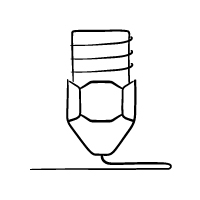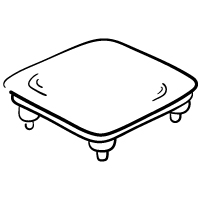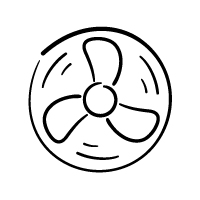TPU
TPU filament, or thermoplastic polyurethane, represents another exciting aspect of 3D printing. It is known for its flexibility and durability, which opens up possibilities for functional prototypes and objects that require resistance to stretching and pressure. Its versatility makes it an excellent choice for projects where traditional filaments may not be able to deliver the same level of performance.
Ease of use
Strength







Extruder
190-210 °C
Does not require any special Hotend


Pray
45-70 °C
Does not require any enclosure


Cooling
100%
For the best bearing bond
When is TPU used?
Thermoplastic Polyurethane (TPU) is a versatile material that finds use in a variety of applications. Thanks to its exceptional flexibility and durability, it is particularly suitable for products and prototypes where a high degree of adaptability is required. In areas such as medical equipment and shoe manufacturing, TPU is used to create products that combine comfort with functionality.
Its ability to resist stretching and pressure makes it a reliable option for the creation of seals, dust covers and other objects that must withstand stress and strain. TPU brings a new dimension of versatility to 3D printing by offering a wide range of uses.
Advantages
- Flexibility
- Shock resistant
- Long service life
Disadvantages
- Does not work with Bowden
- Bad overhangs
- Difficult printing
Tip
Prototypes: TPU enables rapid and precise creation of prototypes across various industries. Its ability to retain shape and flexibility make it an excellent choice for visualizing ideas with high quality and detail.
Products with functional flexibility: TPU is used to create products that require adaptability and flexibility, such as seals, cable covers and elastic components in various industries.
Protective equipment: TPU is often used in the production of protective equipment such as safety helmets, gloves and knee pads thanks to its ability to combine comfort with durability.
Car parts: TPU is used to manufacture automotive parts such as rubber moldings, cable covers and tire applications due to its ability to withstand mechanical stress and weather conditions.
Print speed: Use a medium print speed to maintain accuracy and detail.
Layer Height: Choose an appropriate layer height depending on your project – thinner layers give more detailed results.
Retraction: Adjust the retraction settings to minimize wire strands and impurities in the print.
Bed Adhesion (Adhesion to the Building Plate): Use kapton tape, glass or special printing surface materials to improve adhesion and reduce the risk of shearing.
Check Humidity: Store the PLA material in a dry and sealed container to prevent moisture absorption and quality degradation.
TPU Material Properties and Applications
| Property | TPU |
|---|---|
| Material composition | Thermoplastic Polyurethane |
| Strength | ● ○ ○ |
| Flexibility | Flexible |
| Print quality | ● ● ○ |
| Surface finish | Standard |
| Layer stapling | ● ○ ○ |
| Temperature resistance | ● ○ ○ |
| Applications | Flexible prototypes, Functional parts |
ABS





PETG





Miscellaneous




